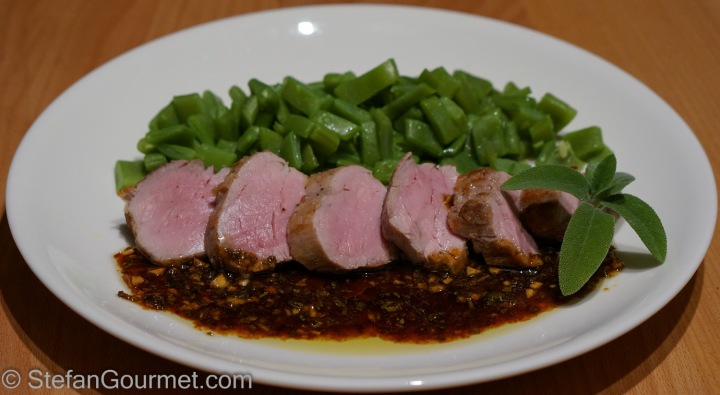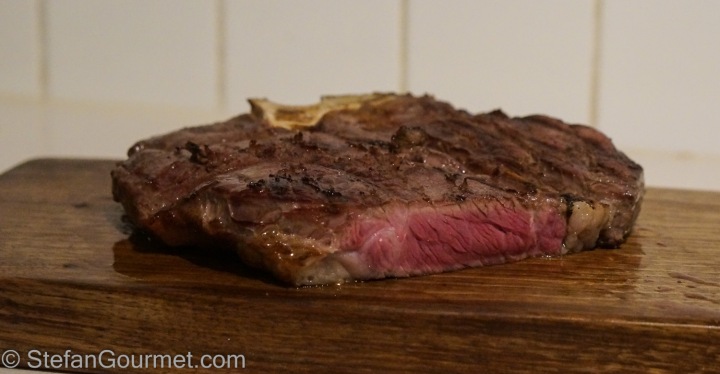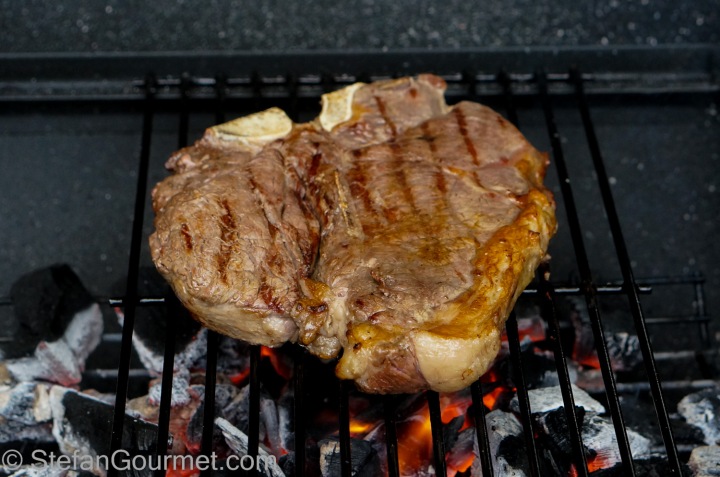Meat tastes good when it is tender, juicy, succulent, flavorful, and looks good. In the previous two parts of this series, I have explained how cooking affects the juiciness of meat, the factors that affect the tenderness of raw meat, and methods how to tenderize meat. In this third part I will explain what makes a piece of meat more succulent and flavorful, and what affects its appearance. For this I will cover three topics:
- Light vs dark meat
- Red vs white meat
- The Maillard reaction
In the next part I will cover food safety, and then we will be ready to use all the knowledge of the first four parts of the series to figure out the best strategies to cook meat.
Light vs dark meat
There are two types of muscle fibers: those that can contract quickly for swift movements and those that contract more slowly for stamina. The fast-twitch muscle fibers are lighter in color than the slow-twitch muscle fibers. Each muscle contains both types, but the proportions vary. Meat that has mostly slow-twitch fibers we refer to as “dark meat” (e.g. chicken legs). These are muscles that are used continuously for breathing, standing, chewing, etc., so they have a lot of endurance. On the other hand, the “light meat” (e.g. chicken breast) has mostly fast-twitch fibers that are used occasionally for sprinting and other fast movements without a lot of stamina. These muscles are more powerful, but have less endurance.

In red meat such as beef, it is more difficult to see the difference between light meat and dark meat, because all of it is red. If you look closely, you will still notice that dark meat (e.g. hanger steak, used for breathing) has a darker hue of red than light meat (e.g. tenderloin).
Dark meat is more flavorful and succulent than white meat. Just think of the difference between chicken breast and chicken thighs. Chicken breast is very tender, but it dries out easily, and even if cooked perfectly it has little flavor. Chicken thighs are less tender, but have more flavor and are more succulent. The most important reason for this is intramuscular fat, also known as marbling. That fat is embedded in the connective tissue. (Because this weakens the connective tissue, fat also helps a bit to make meat more tender.) When you eat a piece of marbled meat, the fat will be released into your mouth together with meat juices and cooked collagen (gelatin). This will lubricate the meat fibers as you chew them, and that is what we refer to as succulence. It also has a huge effect on the flavor, as fat provides much more flavor than lean muscle fibers. It is even true that if you take lean meat of one animal and you mix it with the fat of another animal, you will recognize the meat as coming from the animal from which the fat came. So lean beef + lamb fat tastes like lamb, or lean pork + chicken fat will taste like chicken.

Dark meat has more marbling than white meat, and there is a reason for that. As I explained above, dark meat comes from muscles with a lot of endurance. Those muscles have a storage of intramuscular fat and have the ability to burn that fat to provide the energy needed to keep them going. Slow-twitch muscles can burn fat, but fast-twitch muscles (white meat) can’t. So there wouldn’t be any use to have marbling in white meat.
The best meat that is both flavorful and tender is dark meat from muscles that do not make large, forceful movements in life, so they don’t need strong connective tissue. An example is muscles used for breathing, like hanger steak. They obviously need a lot of endurance so they are dark meat, but the movements are not very forceful so the meat doesn’t need strong connective tissue and is therefore relatively tender.
Red vs white meat
What gives meat its color? You may know that blood is red because of the hemoglobin, the stuff inside blood that carries the oxygen. Muscles do not contain blood, but they do have a way to transport oxygen from the blood to the muscle fibers, and that is myoglobin. Just like hemoglobin, myoglobin is red because of the iron it contains. Myoglobin only looks red when there is oxygen bound to it. This is why blood in your arteries that is rich with oxygen, is brighter red than blood with less oxygen in your veins.
Animals that don’t move a lot, like chickens, do not need a lot of myoglobin. So their meat is white. The dark meat that does have more myoglobin is dark because of it. Animals that need a lot of endurance have a lot of myoglobin and therefore their meat is red. Unlike chickens, ducks are migratory birds that need to be ably to fly long distances. That is why duck meat is red, because their muscles have a lot of myoglobin to carry the oxygen needed for that endurance.

Red meat is different from white meat in both flavor and appearance. The flavor is different because you can actually taste the iron in red meat. When red meat is cooked to less than 60C/140F, the myoglobin will stay intact but it will release the oxygen. And so meat that is cooked medium-rare is pink rather than red. If you cut into it and leave the surface exposed to the air, the myoglobin will catch oxygen from the air and become red again. At temperatures above 60C/140F, the myoglobin will degrade. This is why red meat cooked more than medium will become grey and it won’t become red again when exposed to air. Whether meat looks appealing to you depends on your preference. If you like your steak medium rare, you won’t find a grey color appealing. If you are afraid of undercooked pork, you won’t like it if it is still pink inside (even though it could be perfectly safe to eat).

The Maillard reaction
When meat is exposed to high heat, either directly from a pan or indirectly on a grill or in a hot oven, the outside will become brown (and eventually black). Meat with a crust looks better, also because we know how good that crust will taste. The browning process is known as the Maillard reaction. It is actually not a single chemical reaction, but a complex process of chemical reactions. Those chemical reactions do not just turn the crust brown, they also create a lot of delicious aromas and flavor. This is why grilling meat smells so invitingly delicious.
Although it is often said that the Maillard reaction only works at temperatures above 130C/265F, that is not exactly true. It occurs at much lower temperatures, but very slowly. It is actually not just temperature but also dryness and pH (acidity/alkalinity) that determine the rate of the Maillard reaction. The reaction was discovered in army rations of powdered eggs and powdered milk that turned brown, stored at ambient temperature but very dry. The Maillard reaction will also go faster if the pH is higher.
To speed up the Maillard reaction, you can do three things:
- make sure the meat is dry on the outside;
- increase the temperature;
- increase the pH, for instance by sprinkling with baking powder (which is alkaline and has a high pH); meat that has been marinated in wine (acid, low pH) doesn’t brown easily.
An important point to remember is that meat consists for a large part of water, and at ambient pressure water can’t be heated higher than 100C/212F. When it is heated higher, it becomes steam. When you expose meat to high heat, at first the Maillard reaction doesn’t really get going because the meat is still wet. The energy from the heat source will be used to heat up the water in the meat to the boiling point of 100C/212F. Then it will be turned into steam and escape. The high temperature will also make water evaporate from the meat, so the outside will dry out. When that has happened, the conditions for the Maillard reaction (high temperature and dry) are fulfilled and the Maillard reaction will get going.

Many recipes tell you to brown meat to ‘seal in the juices’. It is a good idea to brown meat because the Maillard reaction will create all those wonderful flavors and aromas, but it won’t seal in any juices. You will notice this when you put meat on a plate after browning; after a while a lot of juices will have leaked from the meat.
Summary
The main points of this article are:
- Dark meat is more succulent and flavorful than white meat.
- The appearance of the outside of meat is changed by the Maillard reaction, which also makes it more flavorful.
- The color of the inside depends on whether it was white or red meat to begin with and to what temperature it has been cooked. How appealing this is depends on your preference for how meat is cooked.
Of course high quality meat from a good butcher will also have better flavor than cheap supermarket meat, as already discussed in the previous article.
This concludes the third article on understanding meat. In the next part I will talk about food safety when cooking meat.




This series should be a must be for all beginner cooks Stefan. You’ve explained clearly all considerations when buying meat and cooking meat. With this knowledge every time a cook prepares meat it should go to the table at it’s best.
LikeLiked by 1 person
Well, I have cooked long enough not to be what I would term ‘a beginner’ but there were quite a few explanations in your post I did not know. the name ‘Maillard reaction’ to begin with. And interesting to know the reasons ‘why’ the differences. . .
LikeLiked by 1 person
My husband is one who did not care for his pink sous vide pork appearance, even though I convinced him it was safe. A high quick sear on the slices took care of that for him.
LikeLiked by 1 person
Did he appreciate how juicy it was compared to regularly prepared pork?
LikeLiked by 1 person
Yes, he said it was the most juiciest and tender pork tenderloin he’s ever had!!!
LikeLiked by 1 person
Good. That is what sousvide will do. Have you tried any 48 or 72 hour cooks at 131-135 degrees yet?
LikeLiked by 1 person
Oh gosh no, but was thinking about it for some brisket but at a bit higher temp.
LikeLike
Please try brisket for 48 hrs at 135F. I promise you won’t regret it. Ask Mimi if you don’t believe me.
LikeLiked by 1 person
OK thank you, I will do that when I make it next!!
LikeLiked by 1 person
I love Steak 😍😍
LikeLiked by 1 person
Hi Stefan
Thank you for yet another inspirational blogpost.
I have promoted your post by adding this post on my blog (in Danish)
One of the bloggers who has meant the most for my interest in sous vide and that really makes some interesting experiments, is the Dutch blogger Stefan Boer, who has got the blog stefangourmet.com.
Stefan takes the job very seriously and makesa large number of comparising experiments in which he is cooking meat from the same cut, at different temperatures and times. These tests are very instructive because you can immediately compare the results.
Stefan has just written three blog posts that I would recommend everyone to take a look at. Whether you cook using sous-vide, or cook in a more traditional way.
Links:
Understanding What Happens To Meat When You Cook It, Part 1: Juiciness
Understanding What Happens To Meat When You Cook It, Part 2: Tenderness
Understanding What Happens two Meat When You Cook It, Part 3: succulence, flavor, and Appearance
The articles are easy to understand, though they are a theoretical examination of what happens to the meat and its structure when it is cooked at different temperatures and why various cuts have different characteristics when it comes to the tenderness, juiciness and flavor.
A thank you to Stefan for his inspirational work
My best regards,
Stig
LikeLiked by 1 person
Hi Stig, thanks so much for your support!
LikeLike
What a great series on meat! You’re the Dutch Harold McGee.
LikeLiked by 1 person
Thank you! He has certainly been an inspiration to me.
LikeLike
And you, sir, to me.
LikeLiked by 1 person
Another excellent explanation Stefan. There is so much good information in here. I will share the series on the One Man’s Meat Facebook page.
LikeLiked by 1 person
Thanks, Conor.
LikeLike
Great info!!
LikeLiked by 1 person
Fantastic, well-presented post, Stefan, and as Sandra mentioned, a must-read for beginning cooks. Heck! I’m no beginner and still found much of the info useful. Thanks for taking the time to organize and present this series.
LikeLiked by 1 person